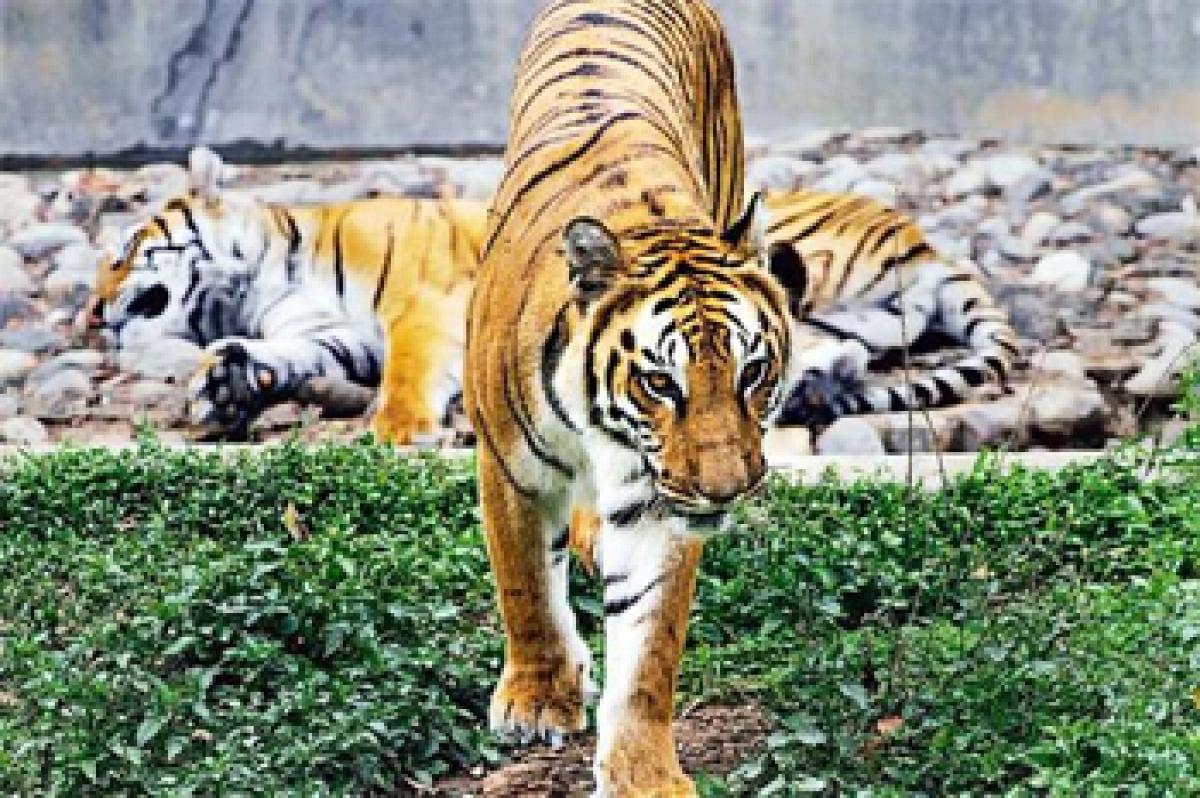Live
- First Impressions and Unboxing of the MacBook Pro M4: A Powerhouse for Professionals and Creators
- China Gears Up for Potential Trade War Amid Trump’s Tariff Threats
- Small Farmers Gain Less by Selling to Supermarkets: Study Reveals
- Why Despite the Controversy, America Is Anticipating the Mike Tyson vs. Jake Paul Fight
- Sanju Samson and Tilak Varma Shine: Record-Breaking Feats in 4th T20I Against South Africa
- India Urges $1.3 Trillion Annual Climate Support for Developing Nations
- Bad air: 106 shuttle buses, 60 extra Metro trips planned to make Delhiites give up cars
- WHO reports declining monkeypox cases in Congo
- CM Attends Kotideepotsavam on Kartika Purnima
- PKL Season 11: Raiding trio of Devank, Ayan, Sandeep help Patna Pirates rout Bengal Warriorz
Just In

India on Tuesday announced an increase in its tiger population -- with 2,500 tigers in the wild from 2,226 in 2014, while the global tiger population has risen from 3,200 to 3,890.
India on Tuesday announced an increase in its tiger population -- with 2,500 tigers in the wild from 2,226 in 2014, while the global tiger population has risen from 3,200 to 3,890.
Environment Minister Prakash Javadekhar said this at the Third Asia Ministerial Conference on Tiger Conservation, adding that India has zero tolerance towards wildlife crime.
The census was based on data fed by 49 tiger reserves across India. However, the region-wise hike was not disclosed.
The numbers also did not incorporate around 90 tiger deaths since 2015, of which 51 deaths were due to poaching and seizures. The survey was conducted by Wildlife Protection Society of India.
"It (poaching) has not hiked that much. If 2,500 is our tiger population today, then around 8-10 cases of poaching are reported in a year. But we are also controlling that and arresting the offenders," Javadekar told IANS.
He said India was close to achieving the resolution to double the tiger population by 22, which was adopted by 13 tiger range countries in 2010 at the "Global Tiger Summit" at St. Petersburg, Russia.
"I am quite positive that we will achieve that target. In 2014, the tiger population was 2,226 while our today's estimate is 2,500, which is commendable. It would be soon proved that we will double the tiger population," he said.
An official from the National Tiger Conservation Authority, of which Javadekar is the chairperson, said the new census was based on phase-4 estimation conducted across India, especially Maharashtra, where data was fed using new camera traps and other sophisticated equipment.
Three new tiger reserves in Assam, Maharashtra and Uttarakhand also improved the census, the official said.
At the conference, India formally endorsed the South Asia Wildlife Enforcement Network (SAWEN), Prime Minister Narendra Modi announced.
SAWEN, with its headquarters in Kathmandu, Nepal, is an initiative to promote regional cooperation among South Asian countries to curb wildlife crime and illegal wildlife trade.
Modi, along with Yeshey Dorji, chairman of the Global Tiger Forum and forest minister of Bhutan, and Javadekar also released a joint report on "Status of Tigers in the Sundarban Landscape - India and Bangladesh".
According to the report, "tiger density estimated using camera traps in the Indian Sundarbans had estimated abundance at 76 tigers".
The government also announced its plan of preserving tiger corridors, by incentivizing private land owners in the tiger areas.
Javadekar also announced that to deal with orphaned or abandoned tiger cubs, a new revised standard operating procedure (SOP) has been laid down.
He said four orphaned tiger cubs were rescued, raised and released in the wild under the initiative.
The environment ministry in coordination with NTCA in August 2014 introduced the SOP to handle orphaned cubs.
Meanwhile, five tiger reserves were awarded at the conference in five different categories.
Periyar Tiger Reserve in Kerala was awarded for best anti-poaching practices, Satpura Tiger Reserve in Madhya Pradesh was awarded for village relocation and settlement, Kanha Tiger Reserve in Madhya Pradesh for active management, Parambikulam Tiger Reserve in Kerala for community participation in eco-tourism and Kaziranga National Park in Assam for conservation of species other than tigers -- the one-horned rhinoceros.
Javadekar said six countries have shown an increase in the number of tigers.
According to sources, tiger population has increased in India, Bangladesh, Bhutan and Russia. The next tiger census is due in 2018.
Representatives from the earlier 13 tiger range countries of Bangladesh, Bhutan, Cambodia, China, Indonesia, India, Laos, Malaysia, Myanmar, Nepal, Russia, Thailand and Vietnam as well as two new ones -- Kyrgyz Republic and Kazakhstan -- participated. The two new countries gained entry for the Snow Leopard.
As per latest data, Bangladesh has 106 tigers, Bhutan 103, Cambodia 0, China 7, India 2,500, Indonesia 371, Lao PDR 2, Malaysia 250, Nepal 198, Russia 433, Thailand 189 and Vietnam less than 5 tigers.

© 2024 Hyderabad Media House Limited/The Hans India. All rights reserved. Powered by hocalwire.com







